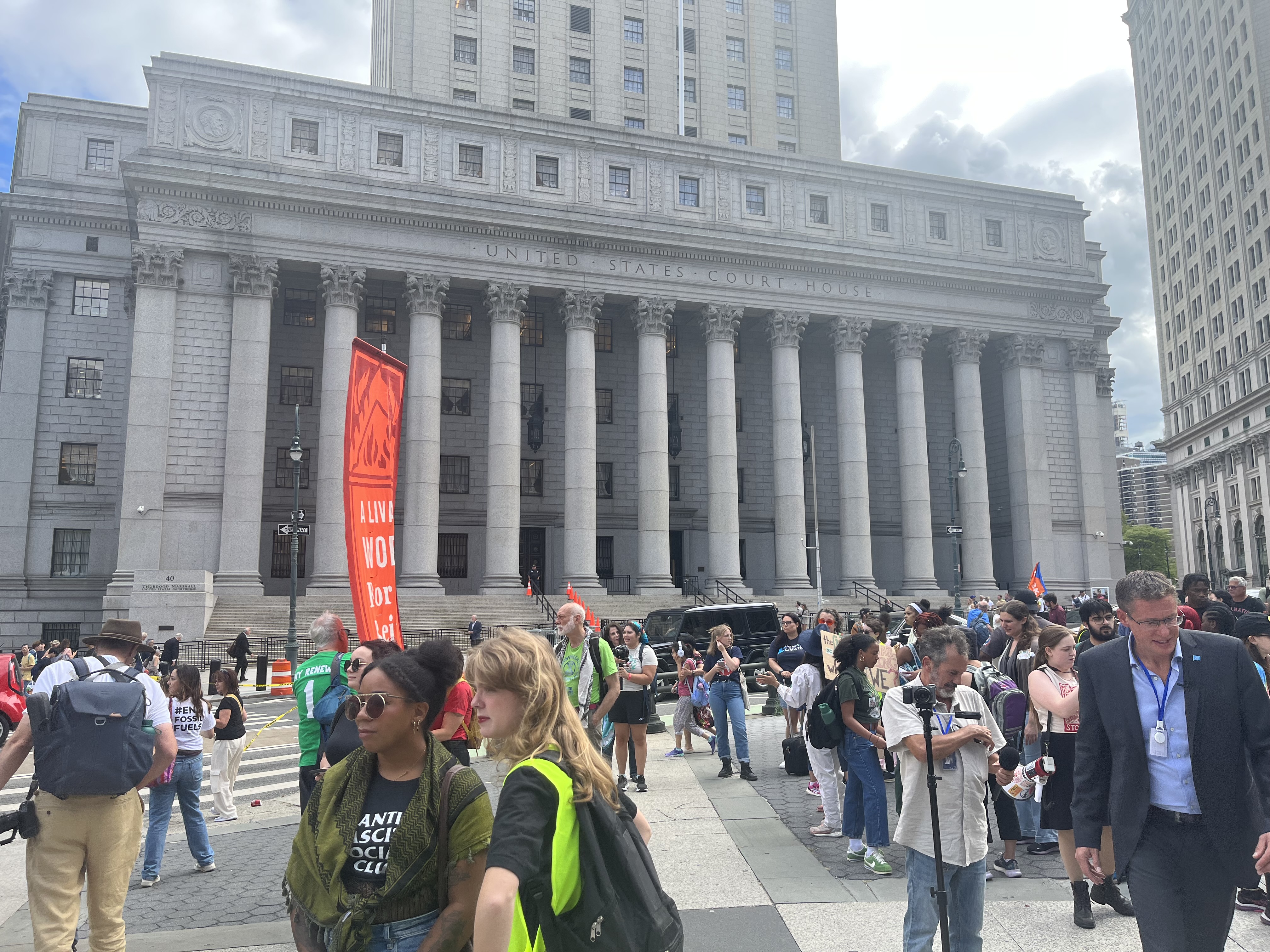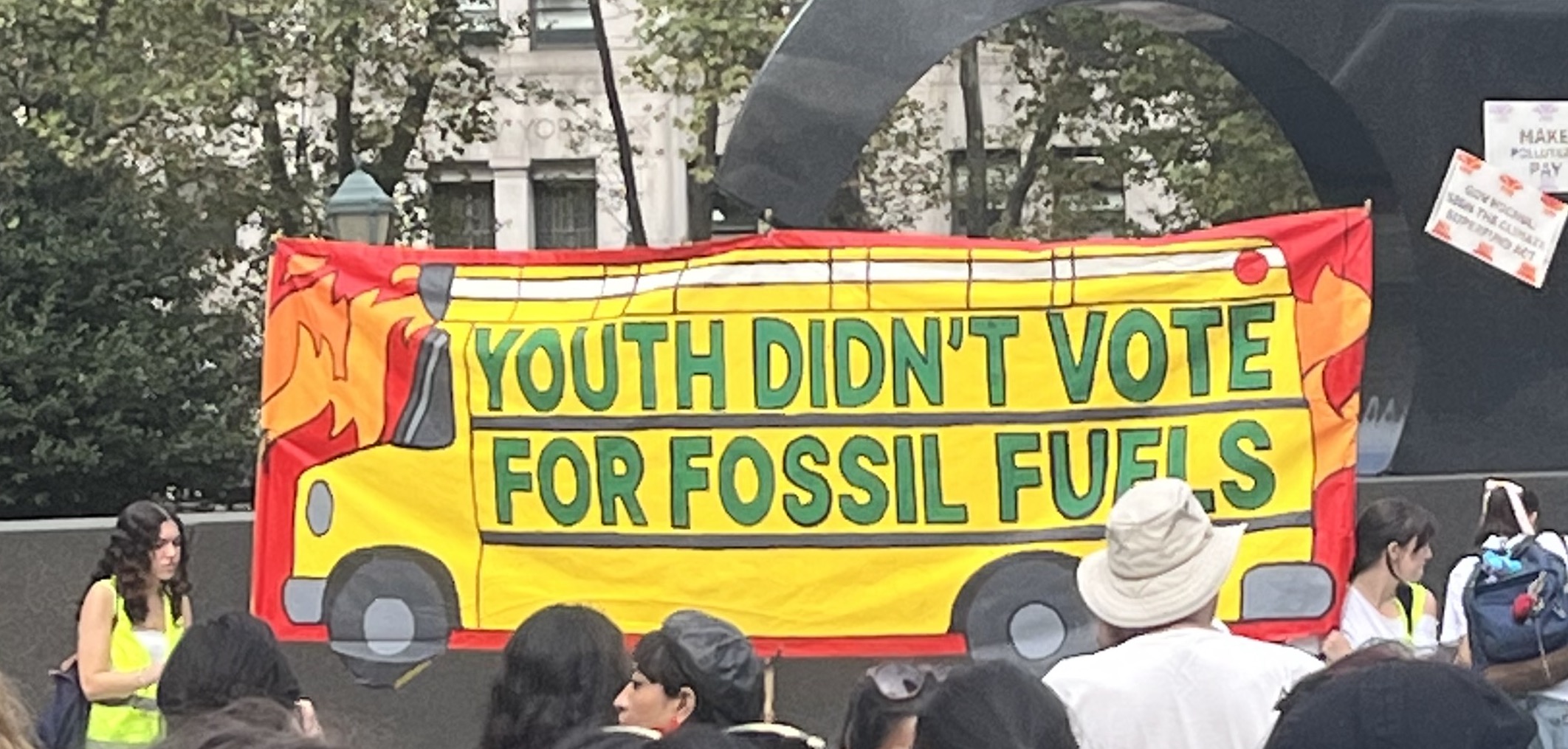Written by: Rashawn Khamari Merchant

Rashawn Khamari Merchant/Earth Shiners
In 2018, due to frustrations regarding the government’s lack of action to address the climate crisis, Greta Thunberg skipped school for two weeks and sat in front of the Swedish Parliament. In an act of defiance many would declare wrong, Thunberg took a step and made it clear that attending school is not worth it if the Earth’s temperatures are steadily moving toward unsustainable levels. Greta Thunberg’s actions eventually led to a global movement of youth who would go against the grain and fight for climate change. Since 2018, the movement known as Fridays for Future has culminated in an international occurrence in which, every Friday, many student groups join to skip school to protest and create awareness around climate action.
Most recently, on Friday, September 20th, 2024, to coincide with the United Nations General Assembly and the beginning of New York City’s Climate Week, Fridays for Future hosted a special event, Global Climate Strike, to call on world leaders to stop using fossil fuels.
The event’s location was highly strategic. Foley Square resides in the heart of Downtown Manhattan’s Civic Center, near City Hall and several city, state, and federal government buildings. The vantage point in the city meant easy access for attendees, including students, organizers, grassroots climate groups, and observers, including journalists and reporters, government officials, and bystanders.

Rashawn Khamari Merchant/Earth Shiners
As part of a class assignment, our professor instructed us to act as observers and ask students survey questions about their motives for attending the protest and whether they had received support from their schools or family members. Surveying was an exciting experience. Initially, feelings of uneasiness came from the perceived notion of asking random upset strangers why they acted upon their dissatisfaction. However, the experience was quite pleasant, as students were more than happy to talk. They especially wanted someone to hear them.
From the perspective of a high school student, many were born after 2005. These birth years indicate that their lives will exist within the most rapid and destructive climate events humanity has ever seen. Most distinctively, these students will also have had the most minor influence on climate change. This fact puts many youths today in an incredibly stressful and anxious place.
Imagine having to deal with a problem while having little influence on its cause. Then, imagine this problem has the power to kill, displace, and starve millions of people around the world. It becomes understandable why students need to speak out and express themselves to the government officials elected to protect them. They feel ostracized by corporations who will do everything in their power to convince these kids to buy from them while slowly sweeping the chance at a sustainable life from under the child’s legs. What is noticeable from speaking to student participants is that they are still faithful to the fact that change can occur, and it is the driving force behind the commitment to showing up to the protests.

Rashawn Khamari Merchant/Earth Shiners
When surveying students, the questions we asked them were demographical and qualitative.
First, we asked them their ages and what schools they attended. In addition, we also sought out an understanding of privilege in the ability to participate. Something notable across all movements, especially climate change, is knowing how sociodemographics influences impacts and the ability to protest. First, those who are economically disadvantaged and belong to minoritized gender, race, and sexual groups tend to face more significant negative consequences in the face of climate events.
If a hurricane hits a poorly constructed development or neighborhood, there is a high chance that recovery efforts will take longer or even impossible to accomplish. Take, for example, the devastation Hurricane Katrina caused in New Orleans, Louisiana, in 2005. Katrina caused over $1 Billion in damages and mainly caused heavy flooding in New Orleans’s Lower 9th Ward, which is a predominately Black and low-income neighborhood. The levee system meant to protect this area completely collapsed, and with the combination of segregation placing these Black residents into areas below sea level, the flood damage was extreme. Some people were never able to regain their property, and much of the damage to infrastructure is still present today. Second, attending a supportive school or living in a more privileged area may suggest an added freedom when skipping school.
We heard from some students that their teachers supported their climate change efforts. In other cases, what is typical at lower-income schools is that many students depend on the school system for breakfast and lunch, while higher-income students may have the affordability to pay for their lunch for the day.
In both cases, skipping school under these conditions showcases immense courage, but it is essential to understand that not all students’ circumstances are the same.
Upon our initial arrival at the Civic Center, at around 1 pm, there were only a few student groups. The event started at 2 pm, and those who came in early attendance were adult organizers, journalists, and reporters beginning to stage the scene. There were several boxes filled with t-shirts, flyers, and snacks. It was clear that the organizers arrived with protest experience. The reporters had large cameras with equipment that effectively cost near the thousands. As more attendees gathered around, people took part in interviews. Many students asked for participation in their podcasts. One student from Ghana openly expressed her frustrations, having come from a part of the world where extreme heat was standard, and compared it to the changing conditions of New York.
Several students gathered around, and we shared our most apparent experiences with climate change, particularly with the arrival of fall. Many felt the temperature was too warm for the autumn season in late September. Others mentioned the lack of snowfall, which was, in fact, a record low during New York’s previous winter season. Like these students, many other students would embark on a journey of creative storytelling and expression to portray their thoughts on climate change. Many students had their cameras for picture-taking and videography. Some students had expressive t-shirts, and others seemed unsure how to move forward. All in all, their presence showcased an effort to find their placement amongst the movement.
After about an hour, an organizer from Fridays for Future stood before the crowd to provide announcements. The group planned to march from Foley Square across the Brooklyn Bridge and stop at the Brooklyn Borough Hall. The announcers were extremely clear and even made the protesters repeat instructions to ensure clarity. The announcements showed that the goal of the protest was not to spark anarchy but to act organized and uniformly. It was impressive to witness this behavior among teenagers, especially given the societal connotation of unruliness among people of that age group.

Rashawn Khamari Merchant/Earth Shiners
Protests slowly began to walk southeast toward the Brooklyn Bridge walkway. Immediately, chants began as people fell into the marching lines. Christina Torres, our teaching assistant, mentioned to the class that many organizers create a marching structure that falls into waves. There is a front line that creates the direction needed for the protestors to follow. At the beginning of the march, there was a large banner from a group reading “Tear Down Fossil Fuels.” This banner provided context for which the rest of the march represented. People wore brightly colored neon safety vests, guiding the marchers along the path. Some rode bicycles to stop traffic, while others ensured the protesters did not spread too far in the street. Safety measures provided safety not only for the protestors but also for bystanders.
Tragedy would strike if someone were to get hit by a vehicle or trampled on. These methods ensure efficiency and safety. Many would feel safer protesting under these conditions. Something that was also fascinating to see was the police presence. Police officers stood by and assisted in helping stop traffic while protestors marched across the street. As the marchers closed in on the Brooklyn Bridge walkway, police cruisers followed closely along the driveways. Christina Torres also mentioned that protest organizations often coordinate with the police to ensure citizen welfare.
The situation was not always favorable during the protest. As Downtown New York is a popular tourist destination, many onlookers were unhappy with the march. On the individual’s faces, people looked disdained and annoyed as a result of having to wait for marchers to walk by. People made sarcastic comments quite frequently. Adverse reactions were especially apparent upon reaching the Brooklyn Bridge. Attentively noticing reactions, there is a wonder of guilt for contributions made toward the climate crisis.
All in all, protesting requires a massive effort of organizing and commitment to a shared goal. The students deserve acknowledgment for their courage in forfeiting the school day. Youth feel they have a message to share and will ultimately rise to defend their cause.

Leave a Reply